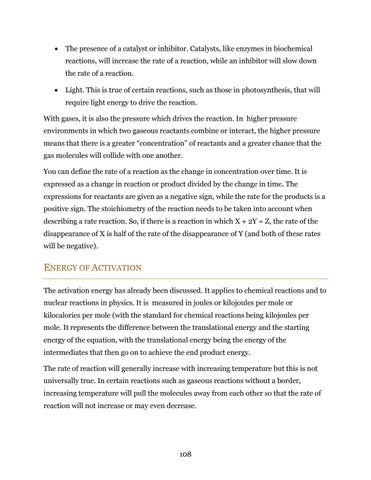•
The presence of a catalyst or inhibitor. Catalysts, like enzymes in biochemical reactions, will increase the rate of a reaction, while an inhibitor will slow down the rate of a reaction.
•
Light. This is true of certain reactions, such as those in photosynthesis, that will require light energy to drive the reaction.
With gases, it is also the pressure which drives the reaction. In higher pressure environments in which two gaseous reactants combine or interact, the higher pressure means that there is a greater “concentration” of reactants and a greater chance that the gas molecules will collide with one another. You can define the rate of a reaction as the change in concentration over time. It is expressed as a change in reaction or product divided by the change in time. The expressions for reactants are given as a negative sign, while the rate for the products is a positive sign. The stoichiometry of the reaction needs to be taken into account when describing a rate reaction. So, if there is a reaction in which X + 2Y = Z, the rate of the disappearance of X is half of the rate of the disappearance of Y (and both of these rates will be negative).
ENERGY OF ACTIVATION The activation energy has already been discussed. It applies to chemical reactions and to nuclear reactions in physics. It is measured in joules or kilojoules per mole or kilocalories per mole (with the standard for chemical reactions being kilojoules per mole. It represents the difference between the translational energy and the starting energy of the equation, with the translational energy being the energy of the intermediates that then go on to achieve the end product energy. The rate of reaction will generally increase with increasing temperature but this is not universally true. In certain reactions such as gaseous reactions without a border, increasing temperature will pull the molecules away from each other so that the rate of reaction will not increase or may even decrease.
108




























